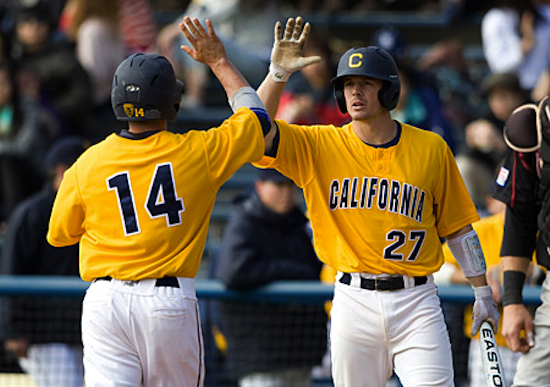Just shy of 9 months ago, the Cal Bears learned, at a meeting with university administrators, that collegiate baseball at California would cease to exist. What’s happened since seems miraculous at times, emotional during all others. Instead of playing out the string of a season’s worth of games, heading day by day toward the gallows where a program would be put to die, supporters of the Cal baseball program fought back. $10 million later, the Bears can keep playing baseball.
And so goes the most ESPN-ready story of the 2011 College World Series. The Cal Bears end this season not by shutting down the program, but by appearing in the school’s first CWS since 1992. To learn more about this year’s Bears, we turned to Jim McGill of The Bear Insider.

(GoldenBearSports.com Photo)
White & Blue Review: Much has been made in the media about the near termination of the Cal baseball program. How did the program avoid shutting down? What affect did the unstable condition of the program have on the players and coaches as the season started?
Jim McGill: The supporters of the program initially joined with supporters of the other sports that were cut and raised over $15 million, but the administration said the majority of the funds pledged were from rugby supporters so they reinstated rugby and lacrosse but said that baseball would need to raise $10 million on their own, which they were eventually able to do, with the charge being led largely by former players.
The players and coaches were angry and confused at first but the likely shutdown of the program united them and likely inspired them to achieve better results than they may have otherwise.
WBR: Cal went just 13-13 in the Pac-10, and then lost their first game of the Houston regional to Baylor. Since, the Bears have won six straight games to claim a spot in the CWS. How did that happen? Who keyed the resiliency during the win streak?
JM: Much of the late-season struggles were due to strength of schedule and the fact that they played 10 of their last 12 games, including the Baylor loss on the road. Most of their final 13 losses also came against regional tournament teams. They also faced a lot of good pitching in those games and their offense struggled.
They’ve been a team that’s closer than most and really rallied around each other. Their closeness and competitiveness combined with strong pitching after Erik Johnson struggled that first day have carried them through. Except for the regional final against Baylor, they’ve gotten strong starts, middle relief and closing.
WBR: The Bears collected 10 or more hits in six of their seven postseason games. Who leads the way for Cal’s offense?
JM: Cal’s gotten strong postseason run production from several sources. Pac-10 Player of the Year Tony Renda has led the team all year and has picked it up even more in the tournament, hitting .364. He played through a calf strain and switched to DH, while Derek Campbell filled in well at 2nd, going 5-for-9. Shortstop Marcus Semien is hitting .393 in the postseason, with 6 runs and 6 RBI. First baseman Devon Rodriguez, who had the game-winning RBI in the regional final victory over Baylor, is hitting .375. Junior catcher Chadd Krist was taken in the 16th round of the MLB Draft. He’s hitting .345 in the postseason play, including 3 doubles, a triple, and a homer. Leadoff man Austin Booker is hitting .323 in the postseason. Right fielder Chad Bunting has shown strong power in the last few games, with 3 homers and 10 RBI, and is hitting .308 in postseason play.
WBR: Friday starter Erik Johnson pitched well in a close loss to Stanford near the end of the regular season. He struggled mightily against Baylor in Cal’s only NCAA Tournament loss thus far. But he bounced back to beat Dallas Baptist Sunday to win the Super Regional. What kind of pitcher is Johnson? What’s his stuff like?
JM: When Johnson is on, he’s one of the toughest pitchers around, with four legit pitches and a definite MLB fastball. He was drafted by the White Sox in the 2nd round. He’s been erratic lately and can struggle with his command, so who knows which Eric Johnson will show up in the CWS? With strong middle and late relief, they’ll probably have a short leash on Johnson this week.
WBR: Who else stands out on the mound for Cal? What is the bullpen dynamic for the Bears?
JM: The Bears’ deep pitching staff is one of their main postseason hopes. Justin Jones, Kyle Porter, Dixon Anderson and Logan Scott have been stellar, as has closer Matt Flener. All sport ERA’s below 2.00 in the postseason.
WBR: Head Coach David Esquer is no stranger to Omaha, having won a national title as a player at Stanford in 1987 and reaching the CWS five times as an assistant for the Cardinal. What kind of coach is Esquer?
JM: Esquer is known as a player’s coach and his team really rallies behind him. He’s a pretty low-key guy but turns up the intensity when he needs it. He’s been able to draw on his postseason experience as both a player and coach to help his team know what to expect.
WBR: The Bears haven’t been to Omaha since 1992. What needs to happen for Cal to make the most of this trip and win the 2011 College World Series?
JM: For Cal to succeed in the CWS, they’ll need to continue to receive timely hitting as they have throughout the postseason so far. They’ll have to figure out a way to get to Danny Hultzen in the opener and keep things close enough to pull out an upset win. They’ll need continued strong pitching and for Johnson not to falter, or it may prove too much to overcome.

